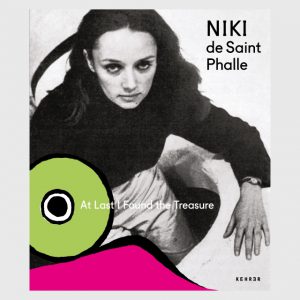©2016 Kehrer Verlag Heidelberg Berlin, Kunst- und Kulturstiftung Opelvillen  Rüsselsheim and authors [and translators!] At Last I Found the Treasure World Fair in Montreal
Rüsselsheim and authors [and translators!] At Last I Found the Treasure World Fair in Montreal
(… …)
ICH and the Monster
In the same year that Niki de Saint Phalle and Jean Tinguely created Paradis fantastique (1967) for the World Fair in Montreal, I met several times with Niki in order to work on the script for the play ICH. As always when she was obsessed with a theme, she was permanently developing her ideas, no matter where she was. Talking with Tinguely about them. Recording every suggestion. Noting them. This meant that, during each of our brief meetings, we would be rejecting an enormous number of schemes in order to give the play a clearer dramaturgical structure. When Beate Kemfert showed me Niki’s draft texts, which she had found in the Niki archive in Santee, California, I was surprised how strongly she identified with the main character. In an early version, for example, she had planned her own facial imprint for the player of the ICH role and even considered singing the part of the opera singer herself. Niki had a very clear soprano voice. She often said: ‘You’ll have to get me drunk to make me sing.’ Looking back, I regret that, at the time, I was too strongly fixated on the rigid structures of a German state theatre and its fixed ensemble to accept such proposals. She had also suggested getting hold of Afro-American musicians from Harlem for the songs. But ideas like those foundered on the performance budget.
At Last I Found the Treasure World Fair in Montreal
In her notebooks for ICH, Niki had initially planned a speaker or conférencier, who was to act as a guide through the numbers of the ICH show. But the narcissistic ICH was lacking the counterpart, whom she could challenge and in whom she could mirror herself.* Whose attention and recognition she needed in order to be stimulated to be stimulated to peak performances. Whom she, for her part, could irritate and provoke into a white-hot rage. We thus introduced, as the protagonist, the monster, which is chorus and bourgeois moral authority at once. A giant hairy colossus, it embraces the whole stage. The monster’s interior is populated by a collective of apelike beings in human clothing, who commentate ICH’s appearances approvingly or disapprovingly with their daily blabber.** Eventually also interfering vehemently (fig. p. 167).
It is only through the monster collective that ICH finds herself, her identity. The monster conditions ICH; just as ICH, in turn, creates the monster in order to be able to tame and dominate it. ICH needs fans and opponents equally, in order to get herself admired or, respectively, to prompt disgust. It is a mutually sympathetic/antipathetic relationship. The conflicting rapport is at its most evident in the first dream scene that we built into the play together. In the dream, ICH desires the monster, and the monster desires ICH as a lover. But the moment there is to be a love union, ICH notices that the monster intends to devour her. Its monstrous red tongue appears under the bed in which ICH dreams, and raises it up.*** ICH escapes the gullet shortly before she gets engulfed. Then ICH provokes the monster a further time by choosing the only partner she deems worthy of her: herself. ICH marries her oversized double in the white bridal gown. After that, she ejects from a massive womb****, which takes in the entire width of the stage, the offspring conceived with herself: Masses of malformed plastic babies tumble onto a conveyor belt and pile themselves in a heap on the forestage. (fig. p. 119). The monster, spurned as a partner, reacts with increasing hostility. Unimpressed by this, ICH dreams another dream. A ‘vision’, as she calls it, which finally reveals to ICH her ‘true destination’.***** This dream is drawn as a continuous comic strip onto a long roll of cardboard, which, filmed by a camera, is projected in the form of a film onto the rear wall of the stage. The dream, which encrypts the author’s partly autobiographically-inspired mythology, points beyond the play in multiple respects, as we shall see later. At Last I Found the Treasure
(… …)
*German: “Aber dem narzisstischen ICH fehlte das Gegenüber, an dem sie sich reiben, in dem sie sich spiegeln konnte.” I had written: “But the narcissistic ICH was lacking the counterpart with whom there could be friction and in whom she could reflect herself.” (No comma!) In my view, “whom she could challenge” does not quite sound strong enough.
**A literal translation of “Alltagsgewäsch”. (I had written: “who commentate ICH’s appearances… with their mindless chatter.”) Perhaps “mundane blabber” would have been more appropriate.
***I had written: “Its monstrous red tongue shoves its way under the bed”, in response to the German: “Seine monströse rote Zunge schiebt sich unter das Bett”. I think some violence or dynamism has been lost in the version that went to print. At Last I Found the Treasure
**** I suspect “birth canal”, as I’d put it, had been more accurate: Gebärschoß.
*****Incorrect change and serious error! I had translated the German — “wahre Berufung” — as “her true calling.” Perhaps “true destiny” was intended?
At Last I Found the Treasure
